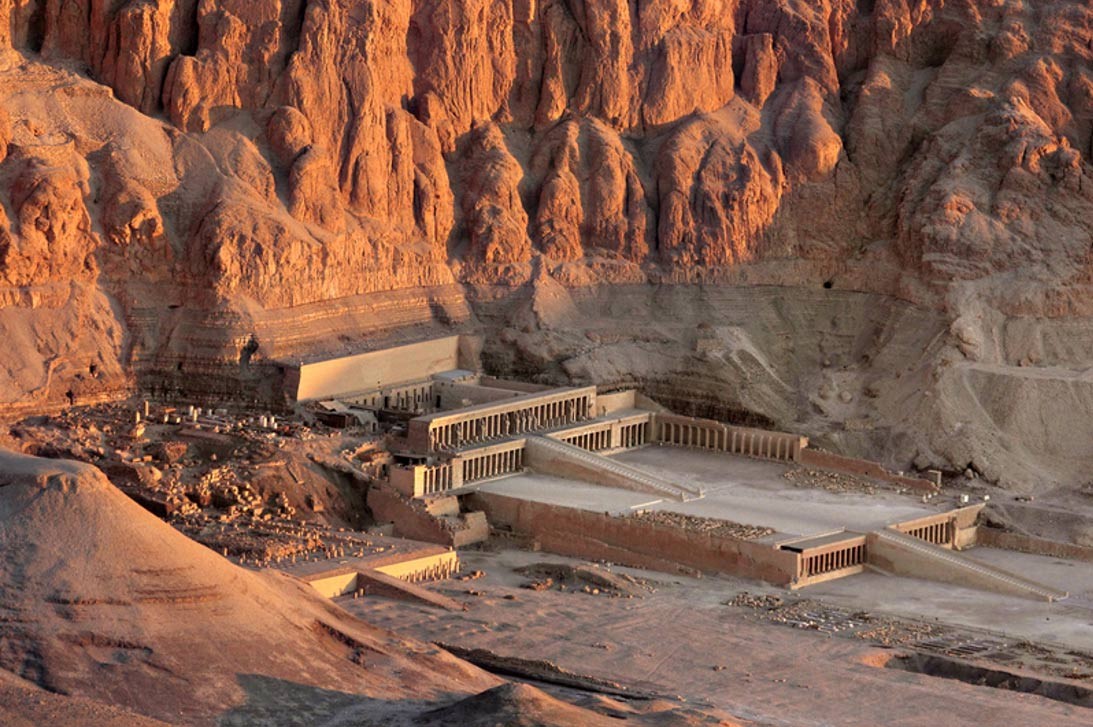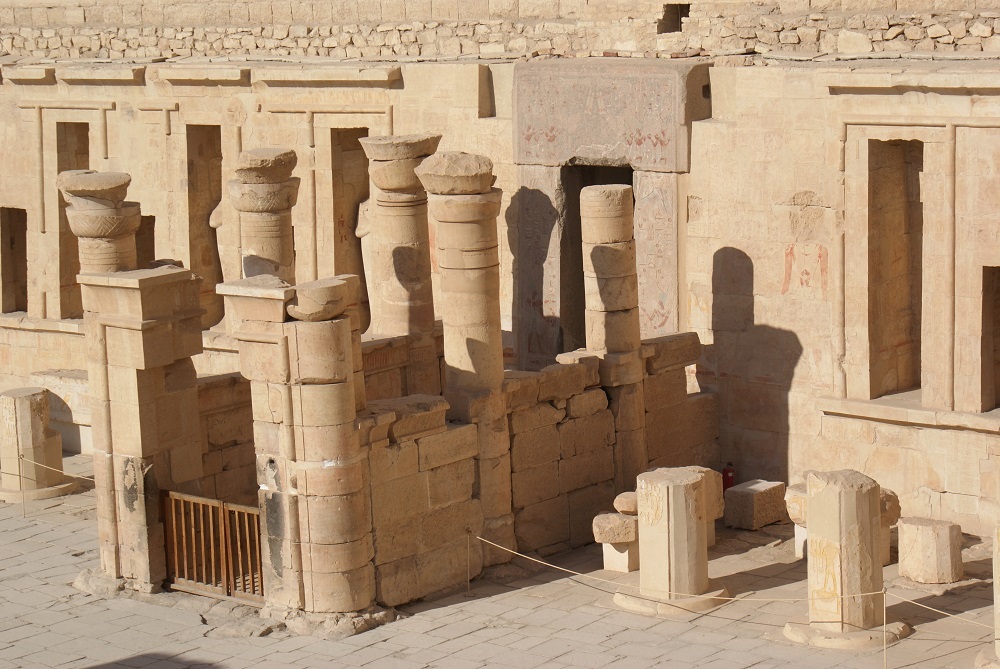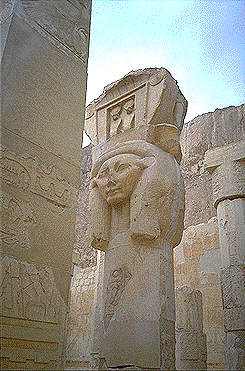Temple Deir el-Bahari: A Wonder of Ancient Egypt

Introduction to Temple Deir El-Bahari
Overview of Temple Deir El-Bahari's history and significance
Temple Deir El-Bahari is located on the west bank of the Nile River near Luxor, Egypt. It was built during the reign of Pharaoh Hatshepsut in the 15th century BCE. The temple is dedicated to the gods Amun and Anubis. It holds great significance in Egyptian history as it showcases the power and influence of Hatshepsut, one of the few female pharaohs in ancient Egypt.
Architectural design and layout of Temple Deir El-Bahari
The temple is constructed in a series of terraces against the cliffs of the Deir El-Bahari valley. It features a unique design with colonnaded halls, statues, and reliefs depicting scenes from Hatshepsut's life. The central part of the temple includes a sanctuary dedicated to Amun, while the lower levels house chapels dedicated to Hathor and Anubis. The temple's layout symbolizes the connection between the earthly and divine realms, reflecting ancient Egyptian beliefs in the afterlife and the journey to the underworld.
Now, as you walk through Temple Deir El-Bahari, you can observe the intricate carvings and hieroglyphics that adorn the walls. These tell stories of ancient Egyptian mythology and royal power. The grandeur of the temple's architecture is a testament to the wealth and artistic sophistication of the New Kingdom period in Egyptian history.

The Mortuary Temple of Hatshepsut
Background of Hatshepsut and her temple
The Mortuary Temple of Hatshepsut, also known as Temple Deir El-Bahari, stands as a testament to the reign of Pharaoh Hatshepsut in ancient Egypt. Constructed in the 15th century BCE on the west bank of the Nile River near Luxor, Egypt, this temple was dedicated to the gods Amun and Anubis.
Its architectural design and layout reflect the power and influence of Hatshepsut, one of the few female pharaohs in Egyptian history. The temple showcases elaborate carvings and hieroglyphics that depict scenes from the life of Hatshepsut, emphasizing her divine connection and status.
Historical and cultural importance of the Mortuary Temple of Hatshepsut
The Mortuary Temple of Hatshepsut holds immense historical and cultural significance in Egyptian history. It symbolises Hatshepsut's successful reign and her efforts to legitimize her rule through monumental architecture. The temple’s layout, with its terraced structure against the cliffs of the Deir El-Bahari valley, symbolizes the ancient Egyptian beliefs in the afterlife and the journey to the underworld.
Through its intricate design and religious significance, the temple reflects the wealth and artistic sophistication of the New Kingdom period. As you explore the temple, you will witness the grandeur of ancient Egyptian architecture and the stories of gods and pharaohs depicted on its walls, offering a glimpse into the rich history of this remarkable civilization.

The Upper Terrace of Temple Deir El-Bahari
Purpose and Significance of the Upper Terrace
The Upper Terrace of the Mortuary Temple of Hatshepsut served as a crucial ceremonial and ritualistic space during ancient Egyptian times. As part of the larger temple complex, the Upper Terrace was where sacred ceremonies and offerings were conducted to honour the gods Amun and Anubis. Its elevated position overlooking the valley below symbolized a connection between the earthly realm and the divine realms, emphasizing the importance of the pharaoh's divine role as a mediator between the gods and the people.
Artwork and inscriptions found on the Upper Terrace
The Upper Terrace is adorned with intricate artwork and inscriptions that tell the stories of Hatshepsut's divine lineage and her achievements as a pharaoh. Carvings on the walls depict scenes of the pharaoh making offerings to the gods, participating in religious ceremonies, and engaging in battle. Hieroglyphics detail the temples’ dedication to the gods and the pharaoh's journey through the afterlife.
The artistic detail and precision of the reliefs showcase the skilled craftsmanship of ancient Egyptian artisans and the importance of conveying religious and historical narratives through art.

The Lower Court and the Punt Colonnade
Description of the Lower Court and its function
The Lower Court of the Temple of Deir El-Bahari was a spacious area surrounded by colonnades and served as a significant part of the temple complex. It functioned as a gathering space for religious processions, ceremonies, and rituals conducted in honour of the gods.
The open courtyard provided a grand entrance to the temple and served as a transitional zone between the outside world and the sacred inner sanctuaries. The columns and walls were decorated with intricate carvings and paintings depicting scenes of offerings, worship, and the pharaoh's interactions with the divine.
Exploration of the Punt Colonnade and its symbolic representations
The Punt Colonnade, located within the Lower Court, was a prominent architectural feature of the temple complex. The colonnade's columns were intricately carved to resemble bundled papyrus plants, symbolizing growth, fertility, and abundance.
The scenes depicted on the colonnade walls showcased Hatshepsut's successful trading expedition to the land of Punt, emphasizing her role as a powerful and prosperous ruler. The symbolic representations of the Punt Colonnade reinforced the pharaoh's connections to the gods and highlighted her ability to maintain balance and harmony within the kingdom.

The Sanctuary of Amun
Overview of the Sanctuary of Amun
The Sanctuary of Amun within the Temple of Deir El-Bahari was a sacred space dedicated to worship the god Amun, one of the principal deities in the Egyptian pantheon. It served as the central religious hub where priests and devotees paid homage to Amun through prayers, offerings, and rituals.
The sanctuary was designed to capture the essence of divine presence and provide a connection between the mortal realm and the spiritual realm, symbolizing the pharaoh's link to the divine authority of Amun.
Religious practices and rituals conducted in the Sanctuary
Within the Sanctuary of Amun, priests performed intricate ceremonies and rituals to honour and appease the god. Offerings of food, incense, and precious objects were presented as gifts to Amun, symbolizing the sustenance and prosperity sought from the deity. Sacred chants and hymns echoed through the halls, creating a reverent atmosphere conducive to communion with the divine.
The sanctuary also housed sacred statues and symbols of Amun believed to embody the god's essence and power, further enhancing the spiritual significance of the space. Worshippers sought blessings, guidance, and protection from Amun, reinforcing the relationship between the pharaoh, the gods, and the people in the eternal cycle of cosmic order.

The Chapels of Anubis and Hathor
Significance of the Chapels of Anubis and Hathor
The Chapels of Anubis and Hathor held great significance in ancient Egyptian religious practices. Anubis, the god of embalming and the afterlife, and Hathor, the goddess of love and motherhood, were revered deities associated with specific aspects of life and death. These chapels were places of worship and offerings dedicated to seeking Anubis and Hathor's protection, guidance, and benevolence.
Depictions and statues found in the chapels
Visitors would find intricate depictions and statues representing the gods in the Chapels of Anubis and Hathor. Anubis was often depicted with the head of a jackal, symbolizing his role in guiding souls to the afterlife.
Hathor, on the other hand, was portrayed with cow-like features, embodying her nurturing and protective qualities. These representations served as focal points for prayers and offerings, connecting worshippers with Anubis and Hathor's divine attributes and influences.
Restoration and Preservation Efforts
Efforts to restore and preserve Temple Deir El-Bahari
Restoration and preservation efforts at the Temple of Deir El-Bahari have been ongoing to ensure the conservation of its architectural and religious significance. Skilled conservationists and archaeologists meticulously work to stabilize the structures, prevent further deterioration, and restore the grandeur of the temple complex.
Through research, analysis, and hands-on restoration techniques, the sanctuary's intricate details and spiritual essence and chapels are carefully preserved for future generations to appreciate.
Challenges faced in maintaining the temple complex
Maintaining the Temple of Deir El-Bahari poses significant challenges due to various factors. The harsh desert climate, exposure to natural elements, and the passage of time have taken a toll on the ancient structures. Preservation requires substantial resources, expertise, and careful planning to address issues such as erosion, structural instability, and damage from previous restoration attempts.
Balancing the need for conservation with the site's accessibility to visitors also presents a challenge, as ensuring both preservation and public engagement is essential for the temple's continued cultural and historical relevance.
